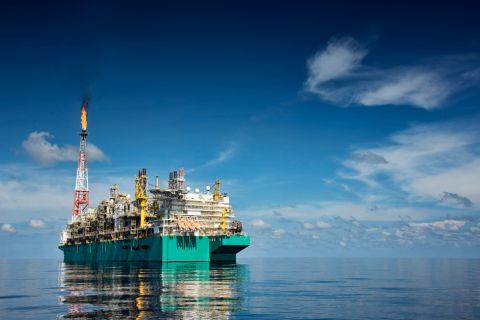
The giant elephant in the E&P room right now, according to analysts with Seaport Global Securities, is that the industry needs to slow down even more. (Source: Hart Energy/Shutterstock.com)
[Editor's note: A version of this story appears in the August 2019 edition of Oil and Gas Investor. Subscribe to the magazine here.]
The conventional wisdom that has guided investors for years is that old dictum: “Sell in May and go away,” the implication being that equities usually trend sideways all summer and start to pick up in earnest in the fall, rising through the end of the year. The problem for us is, oil and gas investors went away way too early.
A lazy second half for drilling might get them to come back. Maybe some good M&A would help too.
It’s said that no E&P company should be public unless it has at least $10 billion in market cap. People want scale. But whatever a company’s size, the spreading desire—no, demand—is that producers slow down their spending pace and, by extension, cap oil and gas production growth. There is too much oil and too much gas. Not enough free cash flow.
While writing about Cabot Oil & Gas Corp., a Seaport Global Securities report said, “Our expectation is for management to address the giant elephant in the E&P room right now: the industry needs to slow down even more. Over the last two quarters, management has implicitly suggested that moderating its production growth in an effort to maximize ROCE [return on capital employed] and free cash flow was the direction the company was likely headed.”
Analyst Paul Sankey of Mizuho Securities USA echoed the theme: “If we can foster capital discipline, we can collectively reduce U.S. oil supply growth that does not generate returns to justify the level of spending and growth. We have lowered our 2H 2019 oil price forecast by $5/bbl, still above strip at $70 Brent for the 3Q, but have also taken about $8/bbl off of next year and are now below strip for 2020. That is not positive for the sector…
“We do think that the best E&Ps can outperform this outlook by capital discipline and cash return growth, through higher multiples, but two-thirds of the oil group and oil services have a very problematic outlook here.
“To repeat, two-thirds of the group—those with higher breakevens and worse balance sheets—have an outright negative outlook into 2020, and until U.S. capital discipline reduces U.S. oil supply growth, there is too much oil. We believe … that Saudi does not want to cut more. On our balances, it may need to.”
Based on conversations just before the second-quarter earnings deluge, Gabriele Sorbara, senior equity analyst at Williams Capital Group, said he thinks “the buy-side models are ahead of the sell-side in considering more modest growth going forward and utilizing strip pricing. Thus, on a net basis, margins and free-cash-flow generation/yield should be more attractive.” Sadly, his universe of E&P companies is down 10% so far this year on average, significantly underperforming the 27.8% gain in the West Texas Intermediate oil price.
So yes, we all agree, keep spending within cash flow and cut capex if you can. But what else is an E&P company supposed to do? Drilling and producing more is their reason for being, especially if they’re public. Many private, tightly held companies are content to keep production humming along, just spending enough maintenance capital to replenish the production, pay the debt and taxes, and keep the family living in the manner to which it is accustomed.
The pressure on publics is extreme in all commodity environments, good or bad, but especially now that investor sentiment has soured.
According to Guggenheim E&P analyst Subash Chandra, “Capital efficiency, rather than resource maximization or diversification, has become the primary M&A rationale in our view. Buyers have tended to be companies with supply chain and logistics competencies. These buyers can accrete value by improving the cash-flow profile of a resource without having to assume any EUR or inventory upside and … can manage large pads and minimize cycle times because of logistical advantages.”
Cowen & Co. analysts revealed the conundrum recently, noting M&A activity within the E&P sector is trending about 82% below the five-year deal count average. “While investors clamor for consolidation, including activist campaigns, the multiple compression toward 5 times forward EBITDAX vs. 8 times just two years ago, and limited disparity in multiples, puts many management teams in a strategic bind, unless they merge with zero premiums.”
Zero premiums? We know how that usually plays out.
Now, we have Callon Petroleum Co. and Carrizo Oil & Gas Inc. (which was under activist investor pressure) merging for scale. We have Comstock Resources Inc. snapping up the much larger Covey Park Energy LLC for the same. EQT Corp., already at huge scale, is under bold new management after a nasty fight.
A year from now, we’ll know if these deals were worth all the angst. We’ll know if consolidation, scale and slower growth are truly what it takes to attain profitability and free cash flow, grab investor attention and management kudos.
Recommended Reading
Balticconnector Gas Pipeline Will be in Commercial Use Again April 22, Gasgrid Says
2024-04-17 - The Balticconnector subsea gas link between Estonia and Finland was damaged in October along with three telecoms cables.
Targa Resources Ups Quarterly Dividend by 50% YoY
2024-04-12 - Targa Resource’s board of directors increased the first-quarter 2024 dividend by 50% compared to the same quarter a year ago.
Canada’s First FLNG Project Gets Underway
2024-04-12 - Black & Veatch and Samsung Heavy Industries have been given notice to proceed with a floating LNG facility near Kitimat, British Columbia, Canada.
Biden Administration Argues Against Enbridge Pipeline Shutdown Order
2024-04-11 - The U.S. argues that shutting down the pipeline could interrupt service and violate a 1977 treaty between the U.S. and Canada to keep oil flowing.


